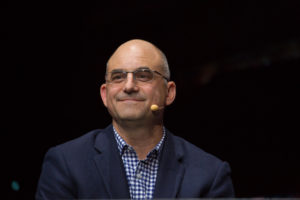 Not many successful SaaS companies have (yet) been built and headquartered in Indianapolis. Scott Dorsey, co-founder and former CEO of ExactTarget, remained true to his roots and turned his Midwestern manners and values in a $1B+ exit – two, to be exact. Whether it’s as CEO of ExactTarget (which he took public in 2012, then sold to Salesforce for $2.5 billion just 15 months later) or Managing Partner at High Alpha, building a strong leadership culture known in the SaaS community for inspiring and empowering employees has always been a key factor to his success as a founder.
Not many successful SaaS companies have (yet) been built and headquartered in Indianapolis. Scott Dorsey, co-founder and former CEO of ExactTarget, remained true to his roots and turned his Midwestern manners and values in a $1B+ exit – two, to be exact. Whether it’s as CEO of ExactTarget (which he took public in 2012, then sold to Salesforce for $2.5 billion just 15 months later) or Managing Partner at High Alpha, building a strong leadership culture known in the SaaS community for inspiring and empowering employees has always been a key factor to his success as a founder.
Gordon Ritter, Founder and General Partner at Emergence Capital and an investor in Scott’s most recent venture High Alpha, joins Scott in this session as he shares his unique journey. They delve into the benefits of building a SaaS company outside of Silicon Valley, M&A from both sides of the table (ET completed six acquisitions, including Pardot, before being acquired by Salesforce), his tenure at Salesforce reporting directly to Marc Benioff, and how his latest venture, High Alpha, is enabling more SaaS companies in the Midwest to follow in his footsteps.
If you’re trying to build a company outside of the Valley, you’d be wise to look to Scott for advice and inspiration.
Check out the full transcript below!
If you want to see more sessions from 2016, we’re releasing a new one each week. Subscribe here to be notified. And be sure to grab your tickets to the 2017 Annual NOW.
TRANSCRIPT
Jason Lemkin: We’ve got another treat. We’ve got Scott Dorsey who, another real unicorn, not a paper unicorn – I got nothing against paper unicorns – but founded ExactTarget, which IPOed and was sold for billions to Salesforce. He’s seen everything. We’ve got Gordon Ritter from Emergence, who’s been a very successful entrepreneur himself, the first investor in Veeva.
They’re old friends, so I’m pretty looking forward to this dialog. I think they’re here. Let’s welcome them out as they come out.
Gordon Ritter: Hey, Jason. Thank you.
Scott Dorsey: All right. Our pleasure, man.
Jason: Take all the time in the world.
Gordon: All right. You got it. Hi, everyone. Whoa. That’s loud.
I think the cocktails have already begun, right? You guys are able to hopefully bring them in here if possible. We’re going to have this be a fun end of the day session with Scott Dorsey. I wanted to say a few words about Scott, but starting off briefly you’ve heard Emergence has been up here quite a bit today, so you’ve heard a little bit about our firm.
Jason Green has gone over our wonderful portfolio. This is about unicorns and I guess I’d like to highlight a company that I’ve had. I’ve been a three time founding entrepreneur from scratch to successful exit prior to founding Emergence.
I’ve had the honor to be chairman of Veeva Systems, which if you haven’t heard, $3 million of capital, luckily it was our capital went in and ultimately took it all the way to a public offering. Now a $400 million run rate public business.
Truly there are few real unicorns out there and Veeva is one that we are just so proud to have as part of the portfolio. We are going to talk about another unicorn today with Scott. Let me give you a quick background on Scott. The critical thing to know about Scott Dorsey and many of you may not have even heard of Scott.
But he is one of the great SaaS CEOs on the planet. The key that you may not have heard about him is he’s not as loud as some of the CEOs that are out there. We know many of the CEOs that do well in this world also have huge personalities that have to dominate.
Scott and company, people like Peter Gassner of Veeva can lead in a very different way. As you get to know Scott today I think you’ll see that. He truly is a quiet leader and a super high integrity leader. He’s from the Midwest and drives an incredible leadership culture that you’ll be hearing about.
Scott grew up in Chicago, graduated from Indiana University and then Kellogg for his MBA. He married his high school sweetheart, ironically, and they have four beautiful daughters at this point. He started ExactTarget with two co-founders in December of 2000, which was after the bubble burst, so this was back when the world had completely imploded is when some of the best companies were started, and led ExactTarget as CEO and chairman from startup all the way through a successful IPO on the Nasdaq in March of 2012 and a $2.5 billion sale to Salesforce.com in July of 2013.
He stayed with Salesforce and led the marketing cloud, which included both ExactTarget, Radiant Six, and Buddy Media for about a year and then recently started High Alpha, which he’ll be talking about, which we have had the great fortune at Emergence to be his lead investor.
I’ve known Scott for about 15 years now and it’s been an amazing opportunity. I not only have a chance to work with him closely, but I really call him a very close friend. It’s wonderful to be able to have both those in my life and I’m honored to be able to be up here with him today.
Scott. Great to be here. First of all, welcome.
Scott: Thank you.
Gordon: Let’s kick off with…help the group understand the root of ExactTarget and how your founding team came together. What made this kick off as well as it did?
Scott: Sure, be happy to, Gordon. Thank you for the kind words and thank you to everyone here, I think this SaaStr show is incredible. I just wanted to say hats off to Jason and the SaaStr organization for pulling this global SaaS community together.
I hear today we have attendees from over 47 countries, which is really remarkable and I think proof point you can start and build amazing software companies anywhere in the world.
We happened to build ExactTarget in Indianapolis. The founding story, Gordon, was three of us, Chris Baggott, Peter McCormick, and I started ExactTarget in late 2000, early 2001 and saw an opportunity to really apply all the database marketing principles that were being utilized in the print world to the online world.
It’s actually my brother-in-law, Chris, we mixed our family and business together and fortunately it worked out remarkably well, but Chris really had the original idea and vision for the business coming out of his database marketing background and his belief, which today feels extraordinarily obvious, is that every organization in the world would be using the Internet and using email specifically to deepen relationships with their customers.
We were three first time software entrepreneurs. In fact, the three of us really didn’t have any software experience. All three of us were really non-technical, coming more from the marketing and general management side.
I had just graduated from Kellogg, where I was studying Internet business models and very much had a prepared mind around the Internet and how it was disrupting business. It was really Chris’s vision for ExactTarget and my newly minted MBA that gave us the courage to give it a start.
Gordon: That’s awesome. What the last speaker commented on, the un-obvious risks that you have to take to have something to be successful, at the time what were the risks that you took? They happened to have paid off obviously brilliantly.
Scott: There were many un-obvious characteristics starting with building a marketing software company in Indianapolis is the first. I would say the second, which we’ve heard quite of bit of discussion on today, is we started by building a platform for small businesses and then eventually moved up to the mid market.
It eventually sold and served many of the largest organizations in the world, Microsoft, Bank of America, Nike, Expedia, and many others. We really stayed true to that SMB to enterprise focus, which stretches the organization in really some remarkable ways when you have customers spending $1,000 or $2,000 a year with you.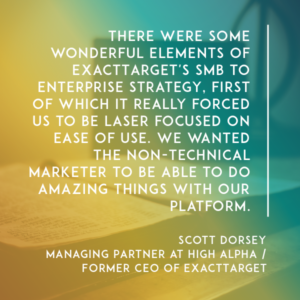
Then on the other end of the spectrum we had some clients that were north of $10 million per year essentially leveraging the same code base. There were some wonderful elements of that SMB to enterprise strategy, first of which, it really forced us to be laser focused on ease of use. We wanted the non-technical marketer to be able to do amazing things with our platform.
Fortunately it turned out the non-technical marketer was living within big organizations and small. We scaled up and down. Every feature we ever built we had an on/off toggle in the back, so we had infinite flexibility around pricing and packaging, which I think is really imperative. Then I’ll tell you. One of the real surprises is that small companies become big companies.
Marketers working for small organizations leave and join enormous enterprises. The virality that SMB to enterprise created for us was really, really exceptional. I’ll just share one quick story. A small little company called Groupon actually came in through our inside sales team, became a customer, started using the ET platform.
Along the way their CEO called me. I actually got Brad Keywell. Brad said, “Hey, Scott. You don’t know me. You don’t know Groupon, but I’m gonna be your largest customer.” I thought, “That’s crazy, but if it turns out to be true, that’d be wonderful.” We built a really amazing relationship.
We were able to serve the needs of Groupon from their startup days to then becoming a really big organization. Then we’ll leverage the daily deal expertise that we built and be able to support daily deal companies all around the world. That was one example where SMB to enterprise turned out to be really spectacular.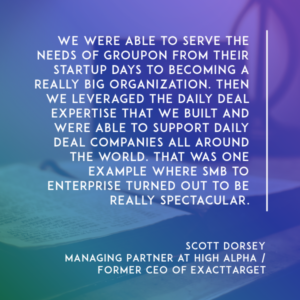
Gordon: Awesome. Well, many of the folks here are from outside of Silicon Valley. What was the opportunity to build ExactTarget in Indianapolis? How did that work for you? What were the positives and negatives to that?
Scott: Sure. As SaaS entrepreneurs you really have to think about what’s your competitive advantage and what are the advantages to your location, to your region? If you’re based in San Francisco, extraordinary talent, amazing network, lots of funding alternatives.
In Indianapolis we had a different set of strengths starting with a central location, very low cost of operation, amazing workforce, amazing universities. Within an hour/hour and a half we were able to reach Indiana University, Purdue, Notre Dame, Rose Hulman, Butler, on and on.
We were able to build a very big brand on campus and create an internship and new college graduate programs that became a big part of our culture. We also were the big fish in a small pond, so we received just incredible support from the city of Indianapolis and the state of Indiana.
Actually in total, over $50 million in economic development incentives because over the course of time we created 1,500/2,000 high tech, high paying jobs.
In a city like Indianapolis that can really move the needle, so we were very proud of building, I think arguably the largest marketing software company in the world and doing it in Indianapolis. We were able to really leverage many of the strengths of the region.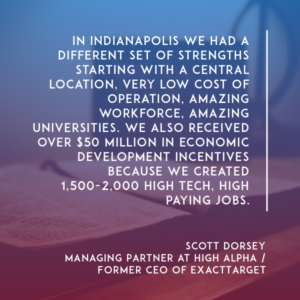
Gordon: I’ve commented on your integrity and Midwestern roots that you brought to the table. Your culture has always been an incredibly strong asset for you. It really is a competitive advantage. How did that culture start? How did you build it to the public offering, and how did it change as you went public?
Scott: Sure. Like many of you, we established core values right at the outset of the business and always thought of the core values as really the framework in which we wanted our employees to make decisions. We wanted to empower our team to the very fullest.
Having core values that they could rely on when making a tough decision allowed us to go much faster than we could have otherwise. Over the course of time it became apparent that our culture was a huge differentiator, not only for attracting amazing people. My goal always was to build an organization that just extraordinarily talented people wanted to be a part of, and wanted to build their career and work incredibly hard to build something really special.
But we kept hearing it from prospects and customers and partners, that our culture was really different. Everybody was so positive and kind and hard working and always put the customer first.
We had a really pivotal time in our history. We had filed to go public in December of ’07. The market started behaving very similar to how it’s been behaving the last couple weeks. We were on file for all of 2008, which was a remarkably difficult period. We had all the burden of being a public company with none of the benefits.
In early ’09, we elected to pull our IPO and actually raise outside capital to really hit the accelerator on growth. This was a time when many of our competitors were pulling back on hiring and expansion. We went the exact opposite direction and had an amazing group of investors really architect that growth strategy.
That was a time when we were 300 or 400 employees. We had a pretty good sense we were going to go to 1,500 or 2,000 very, very quickly. We felt we needed to build our culture framework, and we did so around our preeminent brand color, orange.
I’d always looked across the landscape of software companies and envied Omniture had that amazing green color. You could see that green and just know that was Omniture. At the time, Salesforce was red.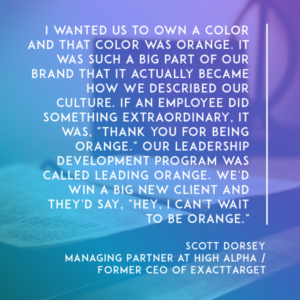
I wanted us to own a color and that color was orange. It became such a big part of our brand that it actually became how we described our culture. If an employee did something extraordinary, it was, “Thank you for being orange.” Our leadership development program was called, Leading Orange.
It really started to gain momentum around our users conference connections. I think you know you’re doing something right with culture when your culture becomes so infectious that your customers and your partners want to become a part of it. Often, we’d win a big new client and they’d say, “Hey, I can’t wait to be orange.”
That orange was really the thread that powered us as a business and really was the common thread across international offices and acquisitions that we were able to pull together later.
Gordon: To that, we want to toggle to the scaling side. You did use M&A and international expansion in pretty powerful ways. Talk to us a little bit about that.
Scott: We did. Over the course of ExactTarget, we completed six acquisitions, three that were geographic expansion and three that were product extension. All in all, they went incredibly well.
We had a strategy around resellers where when we were a very young company and really couldn’t afford to open offices around the world, we would partner with other entrepreneurs and really start resellers where they were selling and servicing ExactTarget. We always thought if things went well, that we’d incorporate them into our business later.
That worked incredibly well. Later we acquired our reseller in the UK, then Australia, then also Brazil.
On the product side, we had amazing depth and expertise around email marketing, but our vision really was around that data model and becoming a multi channeled digital platform. So acquisitions really helped us execute that faster.
We acquired CoTweet, a leading social media platform in 2010. Then in fall of 2012, actually on the same day…We closed two acquisitions on the same day. iGoDigital in the predictive analytics space, amazing company in Indianapolis and then Pardot, one of the leaders in B2B marketing automation down in Atlanta, both of those came together in October of 2012 and helped us a great deal.
Gordon: Let’s talk about the ultimate M&A. Will you talk a little bit about the relationship with Salesforce over the years. You and I spent a lot of time on that over the fits and starts. Touch on that. Then, what was it like to be a part of Salesforce.
Scott: It was an amazing journey. To your point, Gordon, going all the way back to the first couple years of our business, we became a Salesforce customer. That was really one of the best moves we ever made because we had a front row seat at watching how Salesforce really built the SaaS and cloud industry, how they built their technology, how they executed their business model.
Since we were really focused on helping marketers leverage data to communicate with customers in a more meaningful way, we need to connect to data sources and CRM was a very obvious data source to connect to. So we actually integrated with Salesforce prior to the App Exchange existing and really built a very strong partnership with Salesforce over the course of time.
It was very interesting and we’d gone public in March of 2012 and loved it. We had an amazing IPO. We were public for five quarters, really met and exceeded street expectations every quarter. We had executed the two acquisitions, and things were going along swimmingly.
In Salesforce, really started moving more and more directly into the marketing cloud space. They had acquired Radian6 and Buddy Media, really sense that their customers had a big appetite for marketing technology and felt that our technology would really complement what they were doing quite well.
So Mark and John Smoreji, he runs corporate development, he’s going to be speaking tomorrow, came knocking. There’s quite a bit you need to do when you’re a public company around governance and making sure you handle inbound inquiries in a responsible way, which we did.
One thing led to another and we ended up selling to Salesforce in July of 2013 for $2.5 billion. It turned out to be an incredible experience. I felt like I learned so much about how to build and scale SaaS companies, but, whoo, once I got into Salesforce, I felt like that was my Ph.D. in SaaS.
Gordon: Talk more about what was that experience. What were some of the big takeaways from being a part of Salesforce.com?
Scott: Can you guys hear me OK?
Audience: Yeah.
Scott: All right. Good.
Gordon: It was your whiskers were rubbing I think.
Scott: I had an incredible experience at Salesforce. I stayed for one year. It was really important to me to lead the integration and make sure that our employees and our customers were in an amazing place, which I fully expected they would be living within the world of Salesforce.
I was a part of Mark Bennioff’s executive team for a year, had an opportunity to report directly to him and learn so much. A couple lessons that I’ll share…Actually the first one started right here.
The last time I was in this theater was a little over two years ago practicing for Dreamforce. Salesforce, their sense of urgency, their preparation is extraordinary. Before Dreamforce, we did a full run through of the keynote which is two, two and a half hours.
We actually presented from the stage to all Salesforce employees around the world. All employees were given an opportunity to score us, to rate how we did, to give us comments on what worked, what didn’t work.
Gordon: Score him well.
Scott: Salesforce has this amazing culture of transparency and accountability and incorporating feedback in everything they do. We had a speaking coach. We took all that feedback from the employee base and actually made quite a few changes before we went on stage next week at Dreamforce. Preparation, transparency, amazing speed and urgency.
I felt like we moved incredibly fast at ExactTarget. Salesforce was at a whole different gear relative to serving customers, growing, expanding, thinking big. Many of you have probably read or even used…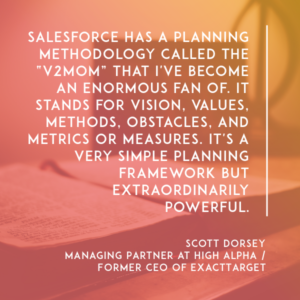
Salesforce has a planning methodology called the v2mom that I’ve become an enormous fan of. It stands for vision, values, methods, obstacles, and metrics or measures. It’s a very simple planning framework but extraordinarily powerful. What it really revealed when you look at the Salesforce culture is a big focus on vision, and thought leadership, and inspiration, but an amazing amount of focus on the details and on the blocking and tackling of the business.
Actually, Mark, obviously, is an extraordinary visionary, but he’s also an excellent manager. He’s very, very focused. During my time at Salesforce, we agreed to three priorities, and we really focused on those three priorities. In fact, [laughs] after the acquisition closed, he said, “Think of me as your Board of Directors.”
Formerly, I had eight or nine members on my board. Now, I had a board of one…
Gordon: But he’s a very large…
Scott: …and his name was Mark.
Gordon: …tall man.
Scott: The three things we focused on, which are important to every SaaS business. More upfront annual billing, important for any SaaS company that you’re trying to capture as much upfront annual billing as you can. That cash flow is so important.
Second is building out the sales organization. We had really built a sales organization that was three or four X the size of our nearest competitor, but in the world of Salesforce, it wasn’t large enough. Salesforce has a rule of thumb that they like roughly 20 percent of their overall headcount to be account executives, quota carrying sales reps, so we did a lot of hiring.
Then, three was really integration, and we were integrating Radian6, Buddy Media, and ExactTarget together. That’s what was a fascinating experience for me, and incredibly challenging, is we were not only integrating ExactTarget into Salesforce.
Then, we were doing a reverse acquisition of bringing Radian6 and Buddy Media together, technologies, organizations, cultures. It was a lot of hard work but very rewarding, and I learned a tremendous amount.
Gordon: Let’s switch gears. You’ve been at one of the largest tech companies on the planet. You’ve built one and then been a part of one, and now, you’re doing High Alpha. Maybe start with the origins of High Alpha and what I get a chance to be a part of, but tell us what you’ve done.
Scott: Gordon, thank you, by the way. Emergence is our lead investor, and I couldn’t imagine a better partner to help us pioneer this new model of entrepreneurship called High Alpha. When I left Salesforce and ExactTarget, I decompressed. It was a fast 12 or 13 years of running and growing the business.
Then, really centered in on, my passions are helping entrepreneurs. I love Software as a Service, and I love Indianapolis and the Midwest. I looked for an opportunity where I could check all three boxes.
I was so fortunate that three of my very good friends, Mike Fitzgerald, Kristian Andersen, and Eric Tobias, had begun founding early stage Software as a Service companies and were really finding unmet needs in the market, disruptive opportunities, and pairing them with capital and with aspiring entrepreneurs. Really, were doing a startup studio nights and weekends.
We got together, the four of us, and said, “Boy, I think there’s a huge opportunity, especially in, I would say, an underdeveloped tech ecosystem like Indianapolis or an emerging tech ecosystem like Indianapolis.”
The matchmaking of big ideas, talented entrepreneurs, and capital takes some work, and if you do it right, you can really produce some amazing, high growth breakout companies. That’s really what we set out to do.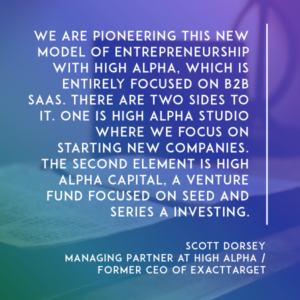
We are pioneering this new model of entrepreneurship, entirely focused on B2B SaaS, and there are two sides to High Alpha. One is High Alpha Studio. We raised $15 million in capital thanks to Emergence is our lead investor. We have about 20 employees, and we’re focused on starting new companies.
We’ve signed up to start 8 to 10 new SaaS companies over the next three to four years. We partner with early stage entrepreneurs. We partner with universities, corporate innovation groups. We’re looking for disruptive ideas in many, many places. Then, we provide capital, and pair up leadership teams, and get those companies off the ground.
The second element to High Alpha is High Alpha Capital, and that’s a venture fund focused on seed and series A investing. We invest in our own companies coming out of the studio, and we also invest in amazing SaaS entrepreneurs that we see around the country where we think we can add some value to their business.
A number of them are in the audience today.
Gordon: One of the things that’s been so special for Emergence is we very much believe in focus. As you’ve heard, we’re squarely focused in the enterprise cloud, and we haven’t ever wanted to do a seed fund. We just think that that just defocuses, takes away what we do. First institutional round is where we’ve spent our time.
This was an opportunity to both have a seed or earlier stage opportunity for Emergence and take some of the ideas we’re seeing that we’re either not yet seeing from you all, new ideas, new concepts, because we’re always trying to think about what’s going to happen next in the cloud, and feed some of those ideas to Scott and his team and see if it creates an interesting opportunity.
This has been an amazing marriage of the two firms and just a great opportunity to work together. Thanks for that.
Scott: Thanks, Gordon. We’re thrilled to be a part of the Emergence team.
Gordon: You did say you put together a bunch of partnerships for High Alpha. Talk a little bit about, again, the differences in the model that you’ve created and how the partnerships are helping out.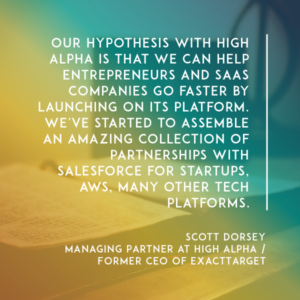
Scott: Yeah, I’d be happy to. Our hypothesis with High Alpha is that we can help entrepreneurs and SaaS companies go faster with us, go faster by launching on the High Alpha platform. We’ve started to assemble an amazing collection of partnerships with Salesforce for Startups, AWS, many other tech platforms.
Actually, today we just announced a partnership with Appirio that we’re really, really thrilled about. Appirio, really one of the leading cloud services companies in the world with headquarters actually in Indianapolis and a large presence here in San Francisco.
Appirio, we’re going to be able to really tap into their services and cloud expertise and leverage their Topcoder crowdsourcing development platform to build software very, very quickly and get it to the marketplace.
We just sent out a press release on the partnership today. We’re partnering up on one company specifically that we hope to be announcing later in the year.
Gordon: It’s a good one. Excellent. Let’s start to wrap up, by which we could open it up to questions. Start to wrap up on given all your experience, if you could give one or two or three pieces of advice, if your younger brother or sister were starting a SaaS company these days, what would the core advice be?
Scott: I’d be happy to. You know what’s occurring to me, Gordon, is I see many people in the audience having a drink and a cocktail. I love that SaaStr started happy hour early, but I haven’t seen a panelist take a sip of a beer yet, so let me give it a try.
Scott: You should do the same. You should do the same, Gordon.
Gordon: I don’t know if the moderator’s allowed to. No, it could be crazy. Maybe as you’re answering.
Scott: My advice gets a lot better, I think, after a beer. Advice to entrepreneurs, what first comes to mind is make sure you’re solving a real problem, and be very passionate about the problem you’re solving.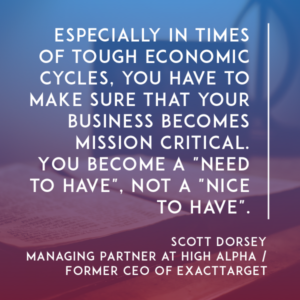
Especially when we head into tougher economic times, and many of you have endured tough economic cycles, and we’re all going to face new ones going forward, you have to make sure that you become mission critical. You become a need to have, not a nice to have.
That comes from really understanding the problem you’re solving and getting extraordinarily close to the customer. That sounds so trite to say, getting close to the customer, but it’s so important. Our chief technology officer, and later my successor, Scott McCorkle, he’s CEO of the Salesforce Marketing Cloud.
When he joined us, he said his goal was to talk to a customer every day. I was like, “Whoa, that’s really hard to do.” You get so busy with internal meetings, with travel, and Scott really upheld that belief of I’m going to talk to a customer every day, and that’s going to help me understand where the market is going.
The beautiful thing about Software as a Service is if you listen, your customers guide you to where you need to go. I think that’s one thing we did a really great job of at ExactTarget is we were extraordinary listeners. We cared deeply about our customers, and we listened.
You can’t build everything your customer wants you to build, but you can discern what’s going to work across the marketplace the closer you get to your customers, so I think that’s incredibly important.
Maybe just the last thing I’ll share is surround yourself with amazing people. Don’t settle for mediocre talent. You need to make sure you have an incredibly high bar around the people you surround yourself with, and always look for extraordinary people that complement each other well and complement you very, very well.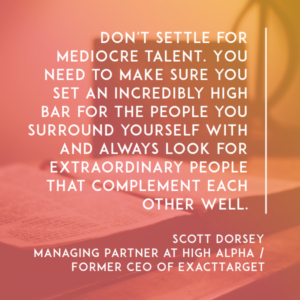
For CEOs of SaaS companies, you really want to surround yourself with amazing people that really complement you and bring a level of diversity into how you think, how you run the business, and surround yourself with advisors that make you want to be better, that raise the bar and make you a better person and a better leader.
I think those are some of the key ingredients. Solve a big problem, stay very, very close to customers, assemble an extraordinary team, and don’t give up. Probably the number one attribute of an entrepreneur is perseverance.
I wish all of you nothing but the greatest success, and stick with it, and go build great companies.
Gordon: Excellent. I want to just say thank you to Scott Dorsey for pulling this off. Well done.
